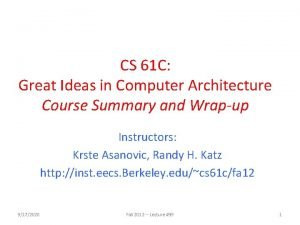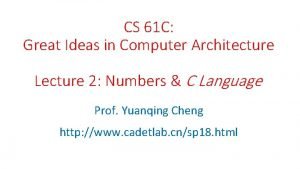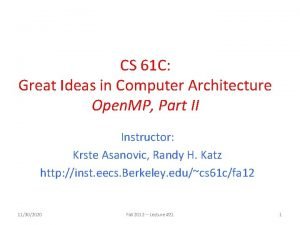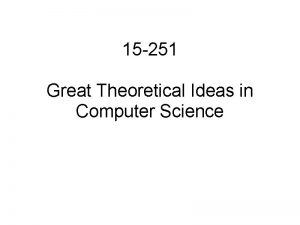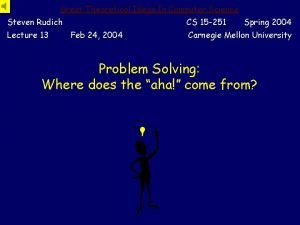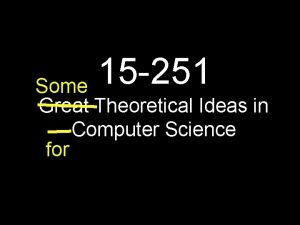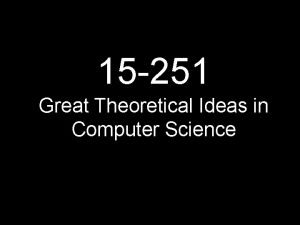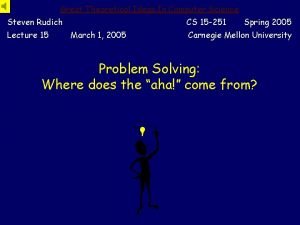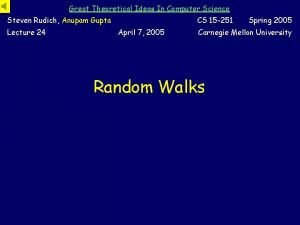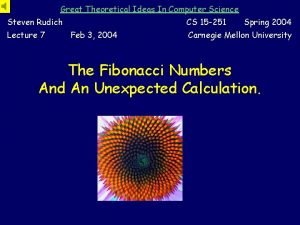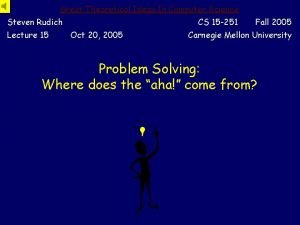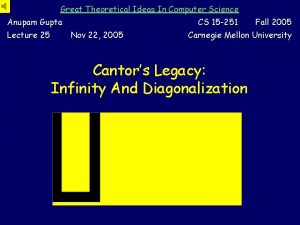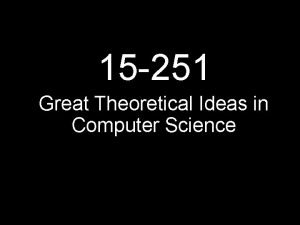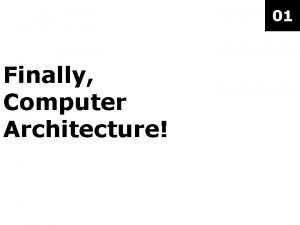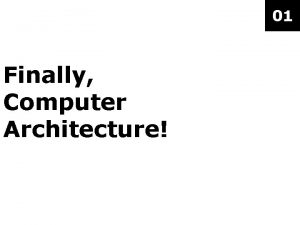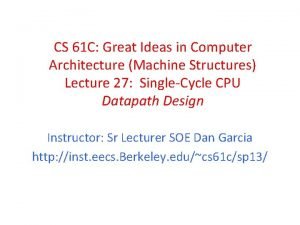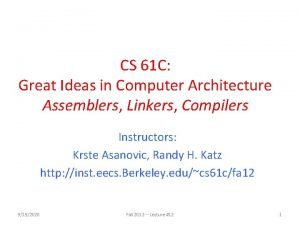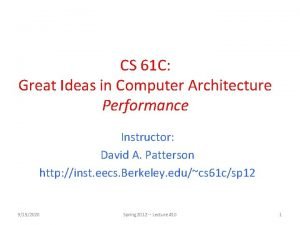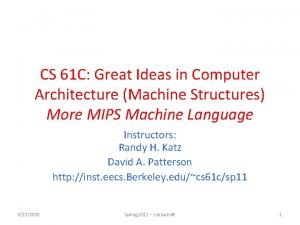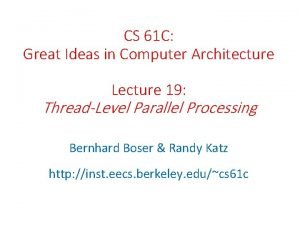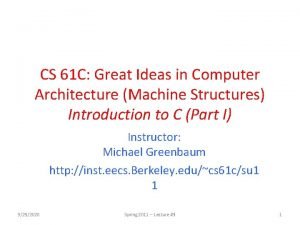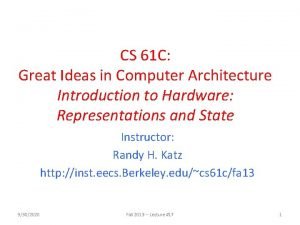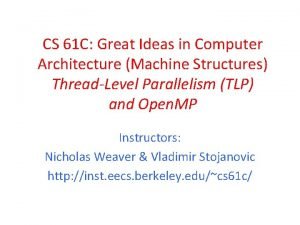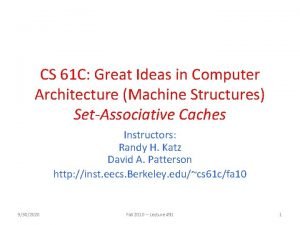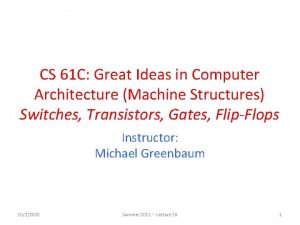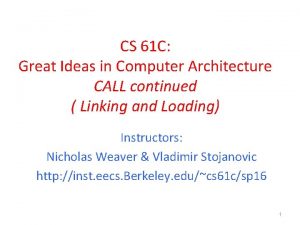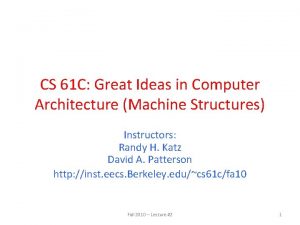CS 61 C Great Ideas in Computer Architecture






























- Slides: 30

CS 61 C: Great Ideas in Computer Architecture Dependability - ECC Nicholas Weaver & Vladimir Stojanovic http: //inst. eecs. berkeley. edu/~cs 61 c/ 1

Great Idea #6: Dependability via Redundancy • Applies to everything from datacenters to memory – Redundant datacenters so that can lose 1 datacenter but Internet service stays online – Redundant routes so can lose nodes but Internet doesn’t fail • Or at least can recover quickly… – Redundant disks so that can lose 1 disk but not lose data (Redundant Arrays of Independent Disks/RAID) – Redundant memory bits of so that can lose 1 bit but no data (Error Correcting Code/ECC Memory) 2

Dependability Corollary: Fault Detection • The ability to determine that something is wrong is often the key to redundancy – "Work correctly or fail" is far easier to deal with than "May work incorrectly on failure" • Error detection is generally a necessary prerequisite to error correction – And as we saw with rowhammer: Errors aren't just errors, but can be potential avenues for exploitation! 3

Dependability via Redundancy: Time vs. Space • Spatial Redundancy – replicated data or check information or hardware to handle hard and soft (transient) failures • Temporal Redundancy – redundancy in time (retry) to handle soft (transient) failures – "Insanity overcoming soft failures is repeatedly doing the same thing and expecting different results" 4

Dependability Measures • Reliability: Mean Time To Failure (MTTF) • Service interruption: Mean Time To Repair (MTTR) • Mean time between failures (MTBF) – MTBF = MTTF + MTTR • Availability = MTTF / (MTTF + MTTR) • Improving Availability – Increase MTTF: More reliable hardware/software + Fault Tolerance – Reduce MTTR: improved tools and processes for diagnosis and repair 5

Availability Measures • Availability = MTTF / (MTTF + MTTR) as % – MTTF, MTBF usually measured in hours • Since hope rarely down, shorthand is “number of 9 s of availability per year” • 1 nine: 90% => 36 days of repair/year • 2 nines: 99% => 3. 6 days of repair/year • 3 nines: 99. 9% => 526 minutes of repair/year • 4 nines: 99. 99% => 53 minutes of repair/year • 5 nines: 99. 999% => 5 minutes of repair/year 6

Reliability Measures • Another is average number of failures per year: Annualized Failure Rate (AFR) – E. g. , 1000 disks with 100, 000 hour MTTF – 365 days * 24 hours = 8760 hours – (1000 disks * 8760 hrs/year) / 100, 000 = 87. 6 failed disks per year on average – 87. 6/1000 = 8. 76% annual failure rate • Google’s 2007 study* found that actual AFRs for individual drives ranged from 1. 7% for first year drives to over 8. 6% for three-year old drives *research. google. com/archive/disk_failures. pdf 7

The "Bathtub Curve" • Often failures follow the "bathtub curve" • Brand new devices may fail – "Crib death" • Old devices fail • Random failure in between https: //upload. wikimedia. org/wikipedia/commons/7/78/Bathtub_curve. svg 8

Dependability Design Principle • Design Principle: No single points of failure – “Chain is only as strong as its weakest link” • Dependability Corollary of Amdahl’s Law – Doesn’t matter how dependable you make one portion of system – Dependability limited by part you do not improve • + Murphy's Law – If you have one thing different, that is the one thing that will fail! 9

Error Detection/Correction Codes • Memory systems generate errors (accidentally flipped-bits) – DRAMs store very little charge per bit – “Soft” errors occur occasionally when cells are struck by alpha particles or other environmental upsets – “Hard” errors can occur when chips permanently fail – Problem gets worse as memories get denser and larger • Memories protected against failures with EDC/ECC • Extra bits are added to each data-word – Used to detect and/or correct faults in the memory system – Each data word value mapped to unique code word – A fault changes valid code word to invalid one, which can be detected 10

Block Code Principles • Hamming distance = difference in # of bits • p = 011011, q = 001111, Ham. distance (p, q) = 2 • p = 011011, q = 110001, distance (p, q) = ? • Can think of extra bits as creating a code with the data • What if minimum distance between members of code is 2 Richard Hamming, 1915 -98 and get a 1 -bit error? Turing Award Winner 11

Parity: Simple Error-Detection Coding • Each data value, before it is • Each word, as it is read from written to memory is “tagged” memory is “checked” by with an extra bit to force the finding its parity (including stored word to have even the parity bit). parity: b 7 b 6 b 5 b 4 b 3 b 2 b 1 b 0 p b 7 b 6 b 5 b 4 b 3 b 2 b 1 b 0 + p + • Minimum Hamming distance of parity code is 2 c • A non-zero parity check indicates an error occurred: – 2 errors (on different bits) are not detected – nor any even number of errors, just odd numbers of errors are detected 12

Parity Example • Data 0101 • 4 ones, even parity now • Write to memory: 0101 0 to keep parity even • Data 0101 0111 • 5 ones, odd parity now • Write to memory: 0101 0111 1 to make parity even • Read from memory 0101 0 • 4 ones => even parity, so no error • Read from memory 1101 0 • 5 ones => odd parity, so error • What if error in parity bit? 13

Suppose Want to Correct 1 Error? • Richard Hamming came up with simple to understand mapping to allow Error Correction at minimum distance of 3 – Single error correction, double error detection • Called “Hamming ECC” – Worked weekends on relay computer with unreliable card reader, frustrated with manual restarting – Got interested in error correction; published 1950 – R. W. Hamming, “Error Detecting and Correcting Codes, ” The Bell System Technical Journal, Vol. XXVI, No 2 (April 1950) pp 147 -160. 14

Detecting/Correcting Code Concept Space of possible bit patterns (2 N) Error changes bit pattern to non-code Sparse population of code words (2 M << 2 N) - with identifiable signature • Detection: bit pattern fails codeword check • Correction: map to nearest valid code word 15

Hamming Distance: 8 code words 16

Hamming Distance 2: Detection Detect Single Bit Errors Invalid Codewords • No 1 bit error goes to another valid codeword • ½ codewords are valid • This is parity 17

Hamming Distance 3: Correction Correct Single Bit Errors, Detect Double Bit Errors Nearest 111 (one 0) Nearest 000 (one 1) • No 2 bit error goes to another valid codeword; 1 bit error near • 1/4 codewords are valid 18

Graphic of Hamming Code • http: //en. wikipedia. org/wiki/Hamming_code 19

Hamming ECC Set parity bits to create even parity for each group • A byte of data: 10011010 • Create the coded word, leaving spaces for the parity bits: • __1_001_1010 1 2 3 4 5 6 7 8 9 a b c – bit position • Calculate the parity bits 20

Hamming ECC • Position 1 checks bits 1, 3, 5, 7, 9, 11: ? _ 1 _ 0 0 1 _ 1 0. set position 1 to a _: • Position 2 checks bits 2, 3, 6, 7, 10, 11: 0 ? 1 _ 0 0 1 _ 1 0. set position 2 to a _: • Position 4 checks bits 4, 5, 6, 7, 12: 0 1 1 ? 0 0 1 _ 1 0. set position 4 to a _: • Position 8 checks bits 8, 9, 10, 11, 12: 0 1 1 1 0 0 1 ? 1 0. set position 8 to a _: 21

Hamming ECC • Position 1 checks bits 1, 3, 5, 7, 9, 11: ? _ 1 _ 0 0 1 _ 1 0. set position 1 to a 0: 0_1_001_1010 • Position 2 checks bits 2, 3, 6, 7, 10, 11: 0 ? 1 _ 0 0 1 _ 1 0. set position 2 to a 1: 011_001_1010 • Position 4 checks bits 4, 5, 6, 7, 12: 0 1 1 ? 0 0 1 _ 1 0. set position 4 to a 1: 0111001_1010 • Position 8 checks bits 8, 9, 10, 11, 12: 0 1 1 1 0 0 1 ? 1 0. set position 8 to a 0: 011100101010 22

Hamming ECC • Final code word: 011100101010 • Data word: 1 001 1010 23

Hamming ECC Error Check • Suppose receive 011100101110 24

Hamming ECC Error Check • Suppose receive 011100101110 25

Hamming ECC Error Check • Suppose receive 011100101110 010111 √ 11 01 11 X-Parity 2 in error 1001 0 √ 01110 X-Parity 8 in error • Implies position 8+2=10 is in error 011100101110 26

Hamming ECC Error Correct • Flip the incorrect bit … 011100101010 27

Hamming ECC Error Correct • Suppose receive 011100101010 010111 √ 11 01 01 √ 1001 0 √ 01010 √ 28

One Problem: Malicious "errors" • Error Correcting Code and Error Detecting codes designed for random errors • But sometimes you need to protect against deliberate errors • Enter cryptographic hash functions – Designed to be nonreversible and unpredictable – An attacker should not be able to change, add, or remove any bits without changing the hash output • For a 256 b cryptographic hash function (e. g. SHA 256), need to have 2128 items you are comparing before you have a reasonable possibility of a collision – This is also known as a "Message Digest" 29

And, in Conclusion, … • Great Idea: Redundancy to Get Dependability – Spatial (extra hardware) and Temporal (retry if error) • Reliability: MTTF & Annualized Failure Rate (AFR) • Availability: % uptime (MTTF-MTTR/MTTF) • Memory – Hamming distance 2: Parity for Single Error Detect – Hamming distance 3: Single Error Correction Code + encode bit position of error • Treat disks like memory, except you know when a disk has failed—erasure makes parity an Error Correcting Code • RAID-2, -3, -4, -5: Interleaved data and parity 30
 Addressing mode in computer architecture
Addressing mode in computer architecture 8 great ideas in computer architecture
8 great ideas in computer architecture Cs61c
Cs61c 8 great ideas in computer architecture
8 great ideas in computer architecture Great theoretical ideas in computer science
Great theoretical ideas in computer science Great theoretical ideas in computer science
Great theoretical ideas in computer science Great theoretical ideas in computer science
Great theoretical ideas in computer science Cse 111
Cse 111 15 251
15 251 Great theoretical ideas in computer science
Great theoretical ideas in computer science Great theoretical ideas in computer science
Great theoretical ideas in computer science Great theoretical ideas in computer science
Great theoretical ideas in computer science Great theoretical ideas in computer science
Great theoretical ideas in computer science Great theoretical ideas in computer science
Great theoretical ideas in computer science Great theoretical ideas in computer science
Great theoretical ideas in computer science Bus design in computer architecture
Bus design in computer architecture Computer architecture vs computer organization
Computer architecture vs computer organization Design of a basic computer
Design of a basic computer Ideas have consequences bad ideas have victims
Ideas have consequences bad ideas have victims Que son las ideas complementarias
Que son las ideas complementarias China big idea
China big idea Turning great strategy into great performance
Turning great strategy into great performance South dakota state symbols
South dakota state symbols With great power comes great responsibility voltaire
With great power comes great responsibility voltaire How are great white sharks different from hammerhead sharks
How are great white sharks different from hammerhead sharks Did alexander the great deserve to be called great
Did alexander the great deserve to be called great Frederick the great education
Frederick the great education With great expectations comes great responsibility
With great expectations comes great responsibility A great deal vs a great many
A great deal vs a great many With great power comes great responsibility batman
With great power comes great responsibility batman Did alexander the great deserve to be called great
Did alexander the great deserve to be called great

